Introduction to Geospatial Analysis in R
Thomas Roh
Data Scientist, HDR
2018-09-05
Software Requirements
- R >= 3.4.3
- R Packages
- sf >= 0.6-3
- sp >= 1.3-1
- ggplot2 >= 3.0.0.9
- leaflet >= 2.0.1
- raster >= 2.6-7
- httr >= 1.3.1
- rvest
- RStudio Deskop (preferred)
- Any other IDE for R will work as well
- Census API Key
Outline
- Introduction to R and GIS
- GIS Data
- Shapefiles, GeoJSON, WKT, rasters
- CRS
- spatial geometries
- Reading Spatial Data into R
- Data Representations
- sp Package
- sf Package
- raster Package
- leaflet Package
- ggplot2 Package
Data Types in R
Data Types in R
typeof(1L)[1] "integer"Data Types in R
typeof(1L)[1] "integer"typeof(1.1)[1] "double"Data Types in R
typeof(1L)[1] "integer"typeof(1.1)[1] "double"typeof(TRUE)[1] "logical"Data Types in R
typeof(1L)[1] "integer"typeof(1.1)[1] "double"typeof(TRUE)[1] "logical"typeof("string")[1] "character"Data Types in R
Data Types in R
typeof(factor(c("string1", "string2")))[1] "integer"Data Types in R
typeof(factor(c("string1", "string2")))[1] "integer"factor(c("string1", "string2"))[1] string1 string2Levels: string1 string2Data Types in R
typeof(factor(c("string1", "string2")))[1] "integer"factor(c("string1", "string2"))[1] string1 string2Levels: string1 string2ordered(c("string1", "string2"))[1] string1 string2Levels: string1 < string2Data Structures in R
Data Structures in R
## all must be of the same typec(1L, 2L)[1] 1 2Data Structures in R
## all must be of the same typec(1L, 2L)[1] 1 2matrix(rnorm(4), ncol = 2) [,1] [,2][1,] -1.267763 -0.4673907[2,] 1.734005 -0.2678249Data Structures in R
## all must be of the same typec(1L, 2L)[1] 1 2matrix(rnorm(4), ncol = 2) [,1] [,2][1,] -1.267763 -0.4673907[2,] 1.734005 -0.2678249str(array(rnorm(8), dim = c(2, 2, 2))) num [1:2, 1:2, 1:2] -1.378 0.351 -1.386 -0.329 -1.006 ...Data Structures in R
## all must be of the same typec(1L, 2L)[1] 1 2matrix(rnorm(4), ncol = 2) [,1] [,2][1,] -1.267763 -0.4673907[2,] 1.734005 -0.2678249str(array(rnorm(8), dim = c(2, 2, 2))) num [1:2, 1:2, 1:2] -1.378 0.351 -1.386 -0.329 -1.006 ...## different data types can be stored togethersapply(list(1L, "string", FALSE, 1.1), typeof)[1] "integer" "character" "logical" "double"Dataframes in R
Dataframes in R
## special class of listdf <- data.frame(x = 1:2, y = c("string1", c("string2")))df x y1 1 string12 2 string2Dataframes in R
## special class of listdf <- data.frame(x = 1:2, y = c("string1", c("string2")))df x y1 1 string12 2 string2df[1,"y", drop = FALSE] y1 string1Dataframes in R
## special class of listdf <- data.frame(x = 1:2, y = c("string1", c("string2")))df x y1 1 string12 2 string2df[1,"y", drop = FALSE] y1 string1df[df$x == 1, names(df) == 'x'][1] 1Subsetting in R
Subsetting in R
df['y'] y1 string12 string2Subsetting in R
df['y'] y1 string12 string2df$y[1] string1 string2Levels: string1 string2Subsetting in R
df['y'] y1 string12 string2df$y[1] string1 string2Levels: string1 string2all.equal(df$y, df[['y']])[1] TRUESubsetting in R
df['y'] y1 string12 string2df$y[1] string1 string2Levels: string1 string2all.equal(df$y, df[['y']])[1] TRUEGIS Data Files (Shapefile)
GIS Data Files (Shapefile)
- Vector geospatial data format specification developed by ESRI to minimize storage space, improve shape drawing speed, and for interoperatibily with GIS software
GIS Data Files (Shapefile)
Vector geospatial data format specification developed by ESRI to minimize storage space, improve shape drawing speed, and for interoperatibily with GIS software
Typically in distributed in a zip file and stored in a directory with at least the following files:
- Main file (.shp)
- Index file (.shx)
- dBASE table (.dbf)
GIS Data Files (Shapefile)
Vector geospatial data format specification developed by ESRI to minimize storage space, improve shape drawing speed, and for interoperatibily with GIS software
Typically in distributed in a zip file and stored in a directory with at least the following files:
- Main file (.shp)
- Index file (.shx)
- dBASE table (.dbf)
- The other most significant file is the projection format (.prj) which supplies the coordinate reference system
GIS Data Files (Shapefile)
Vector geospatial data format specification developed by ESRI to minimize storage space, improve shape drawing speed, and for interoperatibily with GIS software
Typically in distributed in a zip file and stored in a directory with at least the following files:
- Main file (.shp)
- Index file (.shx)
- dBASE table (.dbf)
The other most significant file is the projection format (.prj) which supplies the coordinate reference system
There are many other files that may be in the directory, which can be ignored for now.
GIS Data Files (Shapefile)
Vector geospatial data format specification developed by ESRI to minimize storage space, improve shape drawing speed, and for interoperatibily with GIS software
Typically in distributed in a zip file and stored in a directory with at least the following files:
- Main file (.shp)
- Index file (.shx)
- dBASE table (.dbf)
The other most significant file is the projection format (.prj) which supplies the coordinate reference system
There are many other files that may be in the directory, which can be ignored for now.
GIS Data Files (GeoJSON)
GIS Data Files (GeoJSON)
- Spatial data format developed in line with JavaScript Object Notation (JSON). GeoJSON objects are standardized JSON objects.
GIS Data Files (GeoJSON)
- Spatial data format developed in line with JavaScript Object Notation (JSON). GeoJSON objects are standardized JSON objects.
- All information about the is contained in a single file (.geojson)
- FeatureCollection->Feature->Geometry
- Geometry Types: Point, MultiPoint, LineString, MultiLineString, Polygon, MultiPolygon, and GeometryCollection
- CRS information (optional)
- JSON is a named list of object data, can be nested and assymetrical
GIS Data Files (GeoJSON)
- Spatial data format developed in line with JavaScript Object Notation (JSON). GeoJSON objects are standardized JSON objects.
- All information about the is contained in a single file (.geojson)
- FeatureCollection->Feature->Geometry
- Geometry Types: Point, MultiPoint, LineString, MultiLineString, Polygon, MultiPolygon, and GeometryCollection
- CRS information (optional)
- JSON is a named list of object data, can be nested and assymetrical
{ "type": "Feature", "geometry": { "type": "Point", "coordinates": [ [-96, 43] ] }}GIS Data Files (GeoJSON)
- Spatial data format developed in line with JavaScript Object Notation (JSON). GeoJSON objects are standardized JSON objects.
- All information about the is contained in a single file (.geojson)
- FeatureCollection->Feature->Geometry
- Geometry Types: Point, MultiPoint, LineString, MultiLineString, Polygon, MultiPolygon, and GeometryCollection
- CRS information (optional)
- JSON is a named list of object data, can be nested and assymetrical
{ "type": "Feature", "geometry": { "type": "Point", "coordinates": [ [-96, 43] ] }}GIS Data Files (WKT)
GIS Data Files (WKT)
- Well-known Text (WKT) is a fully open source data specification for spatial objects that is designed to be human and machine readable.
GIS Data Files (WKT)
Well-known Text (WKT) is a fully open source data specification for spatial objects that is designed to be human and machine readable.
A simple text markup language that is easy to store in a text file or in a database as a character string. For databases that do not support spatial objects, you can store as WKT as character strings and use an interpreter in R to read it.
GIS Data Files (WKT)
Well-known Text (WKT) is a fully open source data specification for spatial objects that is designed to be human and machine readable.
A simple text markup language that is easy to store in a text file or in a database as a character string. For databases that do not support spatial objects, you can store as WKT as character strings and use an interpreter in R to read it.
The
printmethod for geometry objects in the sf package will show WKT representation in the console.
GIS Data Files (WKT)
Well-known Text (WKT) is a fully open source data specification for spatial objects that is designed to be human and machine readable.
A simple text markup language that is easy to store in a text file or in a database as a character string. For databases that do not support spatial objects, you can store as WKT as character strings and use an interpreter in R to read it.
The
printmethod for geometry objects in the sf package will show WKT representation in the console.
POINT (-95.9345 41.2565)LINESTRING (-96.05645 41.22345, -95.90417 41.11618)POLYGON ((-95.9345 41.2565, -95.8345 41.2565, -95.9345 41.3565, -95.9345 41.2565))GIS Data Files (WKT)
Well-known Text (WKT) is a fully open source data specification for spatial objects that is designed to be human and machine readable.
A simple text markup language that is easy to store in a text file or in a database as a character string. For databases that do not support spatial objects, you can store as WKT as character strings and use an interpreter in R to read it.
The
printmethod for geometry objects in the sf package will show WKT representation in the console.
POINT (-95.9345 41.2565)LINESTRING (-96.05645 41.22345, -95.90417 41.11618)POLYGON ((-95.9345 41.2565, -95.8345 41.2565, -95.9345 41.3565, -95.9345 41.2565))Source: Open Geospatial Consortium
Spatial Data Types
Spatial Data Types
library(sf)set.seed(82)p <- st_point(c(-95.9345, 41.2565))mp <- st_multipoint(matrix(rnorm(4, sd = .1) + rep(p, each = 2), ncol = 2))l <- st_linestring(mp)ml <- st_multilinestring(list(l + rnorm(4, sd = .05), l - rnorm(4, sd = .05)))plgn <- st_polygon(list(matrix(rep(p, 4) + c(0,0,.1,0,0,.1,0,0), ncol = 2, byrow = TRUE)))mplgn <- st_multipolygon(list(plgn -.15 ,plgn -.2))Spatial Data Types
par(mar = rep(0, 4))plot(p, xlim = p[1]+c(-.1, .01), ylim = p[2]+c(-.2, .1))plot(mp, add = TRUE, col = 'red')plot(l, add = TRUE, col = 'blue')plot(ml, add = TRUE, col = 'orange')plot(plgn, add = TRUE, col = 'purple')plot(mplgn, add = TRUE, col = 'yellow')
Spatial Data Types
par(mar = rep(0, 4))gcol <- st_geometrycollection(list(p, mp, l, ml, plgn, mplgn))plot(gcol, xlim = p[1]+c(-.1, .01), ylim = p[2]+c(-.2, .1))
Reading a Shapefile in with sf
Reading a Shapefile in with sf
states <- st_read('dataWS/states/cb_2017_us_state_500k.shp', stringsAsFactors = FALSE, quiet = TRUE) %>% st_transform(crs = 4326)Reading a Shapefile in with sf
states <- st_read('dataWS/states/cb_2017_us_state_500k.shp', stringsAsFactors = FALSE, quiet = TRUE) %>% st_transform(crs = 4326)str(states)Changing the Coordinate Reference System
states <- st_transform(states, crs = 4326)st_crs(states)Coordinate Reference System: EPSG: 4326 proj4string: "+proj=longlat +datum=WGS84 +no_defs"Changing the Coordinate Reference System
states <- st_transform(states, crs = 4326)st_crs(states)Coordinate Reference System: EPSG: 4326 proj4string: "+proj=longlat +datum=WGS84 +no_defs"states %>% st_transform(crs = 4326) %>% st_crs()Changing the Coordinate Reference System
states <- st_transform(states, crs = 4326)st_crs(states)Coordinate Reference System: EPSG: 4326 proj4string: "+proj=longlat +datum=WGS84 +no_defs"states %>% st_transform(crs = 4326) %>% st_crs()- Common CRS
Mapping with ggplot2
library(ggplot2)ggplot(states[!states$STUSPS %in% c('HI', 'AK', 'AS', 'GU', 'MP', 'PR', 'VI'), ]) + geom_sf(fill = 'transparent', color = 'blue', size = 1) + theme_bw()
Omaha City Limits
cityLimits <- st_read('dataWS/city_limits.csv', stringsAsFactors = FALSE, quiet = TRUE, crs = 4326)bb <- st_bbox(cityLimits, crs = st_crs(4326))tracts <- st_read('dataWS/census_tracts_31/cb_2017_31_tract_500k.shp', stringsAsFactors = FALSE, quiet = TRUE) %>% st_transform(crs = 4326)Omaha City Limits
ggplot(cityLimits) + geom_sf(aes(fill = TOWN)) + geom_sf(data = tracts, fill = 'transparent') + coord_sf(xlim = c(bb$xmin, bb$xmax), ylim = c(bb$ymin, bb$ymax)) + scale_fill_viridis_d(option = 'B') + theme_bw()
Filtering Spatial Data
Filtering Spatial Data
omaha <- cityLimits[cityLimits$TOWN == 'Omaha',]tracts <- tracts[st_intersects(tracts, omaha, sparse = FALSE), ]ggplot(omaha) + geom_sf(aes(fill = TOWN)) + geom_sf(data = tracts, fill = 'transparent') + coord_sf(xlim = c(bb$xmin, bb$xmax), ylim = c(bb$ymin, bb$ymax)) + scale_fill_viridis_d(option = 'B') + theme_bw()
U.S. Census API
U.S. Census API
library(httr)query_acs <- function(var, stateNo, apiKey = Sys.getenv("census_token")) { endpoint <- "https://api.census.gov/data/2016/acs/acs5" varString <- paste0(c("NAME", var), collapse = ",") apiCall <- paste0(endpoint, "?get=", varString, "&for=tract:*&in=state:", stateNo, "&key=", apiKey) response <- GET(apiCall) census <- content(response) census <- lapply(census[-1], function(x) { setNames(data.frame(x, stringsAsFactors = FALSE), nm = census[[1]]) }) census <- Reduce(rbind, census) census[['geo_id']] <- paste0(census$state, census$county, census$tract) census}census <- query_acs(c("B00001_001E", "B06011_001E"), 31)census[1,] NAME B00001_001E B06011_001E state1 Census Tract 9654, Adams County, Nebraska 924 32048 31 county tract geo_id1 001 965400 31001965400US Census: User Guide, Census Variables, Examples
Chloropleths
Chloropleths
names(census)[1:3] <- c('description', 'population', 'median_income')census[['population']] <- as.numeric(census[['population']])census[['median_income']] <- as.numeric(census[['median_income']])tracts <- merge(tracts, census, by.x = 'GEOID', by.y = 'geo_id')tracts[['density']] <- tracts[['population']]/(tracts[['ALAND']]/1000000)ggplot(tracts) + geom_sf(aes(fill = density)) + scale_fill_viridis_c(name = 'Population Density (per km2)') + theme_bw()
tracts[['description']][which.max(tracts$density)][1] "Census Tract 39, Douglas County, Nebraska"Interactive Mapping
library(leaflet)tracts <- tracts[tracts$median_income > 0,]centroids <- st_centroid(st_union(omaha))tractBaseMap <- leaflet(tracts) %>% addTiles() %>% setView(centroids[[1]][1], centroids[[1]][2], zoom = 10)tractBaseMapColor Palettes
pal <- colorNumeric("viridis", tracts$median_income)palBin <- colorBin('viridis', tracts$median_income, 5)palQuant <- colorQuantile('viridis', tracts$median_income, 5)tractMap <- tractBaseMap %>% addPolygons(color = ~pal(median_income), group = 'Continuous', weight = 1, fillOpacity = .5) %>% addLegend(pal = pal, values = ~median_income, group = 'Continuous Legend', position = 'bottomright')tractMapLegends
tractMap <- tractMap %>% addPolygons(color = ~palBin(median_income), group = 'Bin', weight = 1, fillOpacity = .5) %>% addPolygons(color = ~palQuant(median_income), group = 'Quantile', weight = 1, fillOpacity = .5) %>% addLegend(pal = palBin, values = ~median_income, group = 'Bin Legend', position = 'bottomright') %>% addLegend(pal = palQuant, values = ~median_income, group = 'Quantile Legend', position = 'bottomleft') %>% addLayersControl(baseGroups = c('Continuous', 'Bin', 'Quantile'), overlayGroups = c('Continuous Legend', 'Bin Legend', 'Quantile Legend'))tractMapOmaha Building Violations
violations <- st_read( 'dataWS/OPBCV/Omaha_Planning_Building_Code_Violations.shp', quiet = TRUE, stringsAsFactors = FALSE) %>% st_transform(crs = 4326)vColors <- ifelse(grepl('Closed', violations$StatusCurr), 'black', 'red')tdown <- makeAwesomeIcon('thumbs-down', library = 'fa', markerColor = 'white', iconColor = vColors, squareMarker = TRUE)Markers/Points
tractMap <- tractBaseMap %>% addPolygons(color = ~pal(median_income), group = 'Continuous', weight = 1, fillOpacity = .5) %>% addLegend(pal = pal, values = ~median_income, group = 'Continuous Legend', position = 'bottomright') %>% addAwesomeMarkers(data = violations, icon = tdown, clusterOptions = markerClusterOptions(), popup = ~paste( "<b>Permit:</b>",PermitNum, "<br>", "<b>Type:</b>", CaseType, "<br>"))tractMapSpatial Aggregation of Violations
violWithin <- st_within(violations, tracts, sparse = FALSE)nViol <- colSums(violWithin)nViol[1:5][1] 64 83 66 47 71sum(nViol)[1] 4325nrow(violations)[1] 4331tracts <- cbind(tracts, nViol)ggplot(tracts) + geom_sf(aes(fill = nViol)) + geom_sf(data = violations[ rowSums(violWithin) == 0, ], color = 'red') + scale_fill_viridis_c(option = 'plasma') + theme_bw()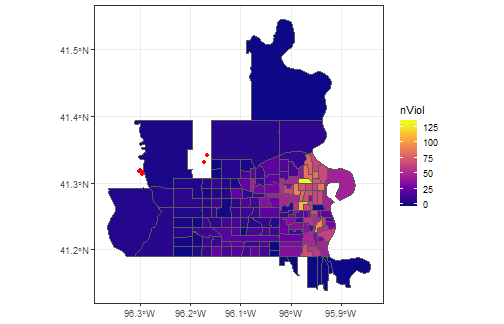
Year Structures Were Built
yrBuilt <- query_acs(paste0("B25034_", sprintf("%03.f", 1:11), "E"), 31)head(yrBuilt, 5) NAME B25034_001E B25034_002E1 Census Tract 9654, Adams County, Nebraska 1866 122 Census Tract 9655, Adams County, Nebraska 1689 03 Census Tract 9656, Adams County, Nebraska 2246 54 Census Tract 9657, Adams County, Nebraska 728 05 Census Tract 9658, Adams County, Nebraska 1036 0 B25034_003E B25034_004E B25034_005E B25034_006E B25034_007E B25034_008E1 27 338 282 241 333 1402 8 140 36 77 301 1733 23 131 354 52 361 2214 0 15 41 14 47 425 0 16 0 4 75 128 B25034_009E B25034_010E B25034_011E state county tract geo_id1 73 58 362 31 001 965400 310019654002 240 143 571 31 001 965500 310019655003 174 366 559 31 001 965600 310019656004 54 46 469 31 001 965700 310019657005 332 121 360 31 001 965800 31001965800yrBuilt <- yrBuilt[ ,!names(yrBuilt) %in% c('state', 'county', 'tract', 'NAME')]Querying Census Data Labels
query_acs_var <- function(var) { endpoint <- "https://api.census.gov/data/2016/acs/acs5/variables/" x <- lapply(paste0(endpoint, var), function(x) {content(GET(x))}) setNames(sapply(x, getElement, 'label'), var)}varNames <- query_acs_var(paste0("B25034_", sprintf("%03.f", 1:11), "E"))varNames[1:5] B25034_001E "Estimate!!Total" B25034_002E "Estimate!!Total!!Built 2014 or later" B25034_003E "Estimate!!Total!!Built 2010 to 2013" B25034_004E "Estimate!!Total!!Built 2000 to 2009" B25034_005E "Estimate!!Total!!Built 1990 to 1999"Prepare the Data
varNames <- gsub(" ", "_", gsub('[A-Za-z]+\\!\\!', "", varNames))varNames B25034_001E B25034_002E B25034_003E "Total" "Built_2014_or_later" "Built_2010_to_2013" B25034_004E B25034_005E B25034_006E "Built_2000_to_2009" "Built_1990_to_1999" "Built_1980_to_1989" B25034_007E B25034_008E B25034_009E "Built_1970_to_1979" "Built_1960_to_1969" "Built_1950_to_1959" B25034_010E B25034_011E "Built_1940_to_1949" "Built_1939_or_earlier"names(yrBuilt)[1:11] <- varNames[names(yrBuilt)[1:11]]yrBuilt[, -12] <- lapply(yrBuilt[, -12], as.numeric)yrBuilt <- na.omit(yrBuilt)tracts <- st_as_sf(tracts, crs = 4326)tracts <- merge(tracts, yrBuilt, by.x = 'GEOID', by = 'geo_id')tracts <- as.data.frame(tracts)class(tracts)[1] "data.frame"trainDT <- tracts[ , c('Built_1939_or_earlier', 'Built_1940_to_1949', 'Built_1950_to_1959', 'Built_1960_to_1969', 'Built_1970_to_1979', 'Built_1980_to_1989', 'Built_1990_to_1999', 'Built_2000_to_2009', 'Built_2010_to_2013', 'Built_2014_or_later', 'Total', 'density', 'median_income', 'nViol')]trainDT[['built_1949']] <- trainDT$Built_1939_or_earlier + trainDT$Built_1940_to_1949trainDT[['built_1969']] <- trainDT$Built_1950_to_1959 + trainDT$Built_1960_to_1969trainDT[['built_1989']] <- trainDT$Built_1970_to_1979 + trainDT$Built_1980_to_1989trainDT[['built_1990']] <- trainDT$Built_1990_to_1999 + trainDT$Built_2000_to_2009 + trainDT$Built_2010_to_2013 + trainDT$Built_2014_or_latertrainDT <- trainDT[-c(1:10)]Train a Model
poissonModel <- glm(nViol ~ ., family = 'poisson', data = trainDT)summary(poissonModel)Call:glm(formula = nViol ~ ., family = "poisson", data = trainDT)Deviance Residuals: Min 1Q Median 3Q Max -9.1355 -1.6920 0.2232 1.2533 6.4402 Coefficients: (1 not defined because of singularities) Estimate Std. Error z value Pr(>|z|) (Intercept) 4.526e+00 6.822e-02 66.339 < 2e-16 ***Total -1.830e-04 6.183e-05 -2.960 0.00308 ** density -1.188e-03 1.856e-04 -6.398 1.57e-10 ***median_income -6.522e-05 2.261e-06 -28.848 < 2e-16 ***built_1949 1.254e-03 6.716e-05 18.680 < 2e-16 ***built_1969 5.714e-04 6.993e-05 8.171 3.05e-16 ***built_1989 4.775e-04 8.706e-05 5.484 4.15e-08 ***built_1990 NA NA NA NA ---Signif. codes: 0 '***' 0.001 '**' 0.01 '*' 0.05 '.' 0.1 ' ' 1(Dispersion parameter for poisson family taken to be 1) Null deviance: 4104.8 on 161 degrees of freedomResidual deviance: 1061.4 on 155 degrees of freedomAIC: 1776.6Number of Fisher Scoring iterations: 5Singularity
alias(poissonModel)Model :nViol ~ Total + density + median_income + built_1949 + built_1969 + built_1989 + built_1990Complete : (Intercept) Total density median_income built_1949 built_1969built_1990 0 1 0 0 -1 -1 built_1989built_1990 -1Results
poissonModel <- glm(nViol ~ ., family = 'poisson', data = trainDT[,-1])summary(poissonModel)Call:glm(formula = nViol ~ ., family = "poisson", data = trainDT[, -1])Deviance Residuals: Min 1Q Median 3Q Max -9.1355 -1.6920 0.2232 1.2533 6.4402 Coefficients: Estimate Std. Error z value Pr(>|z|) (Intercept) 4.526e+00 6.822e-02 66.339 < 2e-16 ***density -1.188e-03 1.856e-04 -6.398 1.57e-10 ***median_income -6.522e-05 2.261e-06 -28.848 < 2e-16 ***built_1949 1.071e-03 3.782e-05 28.332 < 2e-16 ***built_1969 3.884e-04 5.340e-05 7.273 3.51e-13 ***built_1989 2.945e-04 5.688e-05 5.177 2.25e-07 ***built_1990 -1.830e-04 6.183e-05 -2.960 0.00308 ** ---Signif. codes: 0 '***' 0.001 '**' 0.01 '*' 0.05 '.' 0.1 ' ' 1(Dispersion parameter for poisson family taken to be 1) Null deviance: 4104.8 on 161 degrees of freedomResidual deviance: 1061.4 on 155 degrees of freedomAIC: 1776.6Number of Fisher Scoring iterations: 5Model Diagnostics
par(mfrow = c(2,2))plot(poissonModel)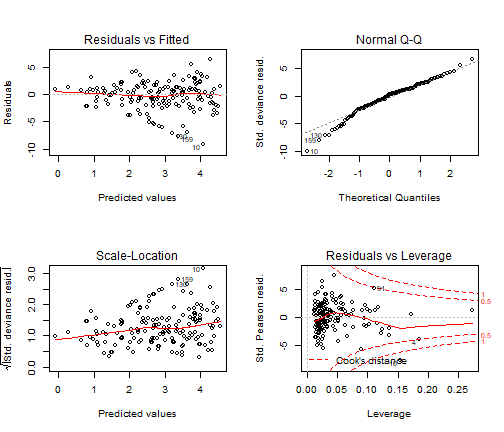
Model Error
tracts[['pred_nViol']] <- predict(poissonModel, type = "response")tracts[['pred_error']] <- tracts$nViol-tracts$pred_nViolqplot(poissonModel$y, predict(poissonModel, type = "response")) + geom_abline(slope = 1, intercept = 0, color = 'red') + labs(x = 'Actual', y = 'Predicted') + theme_bw()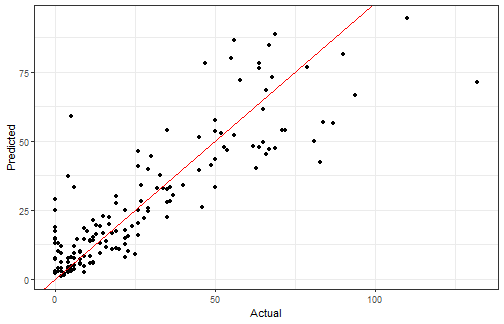
Spatial Comparison
ggplot(tracts) + geom_sf(aes(fill = nViol)) + labs(fill = 'Violations') + scale_fill_viridis_c() + theme_bw()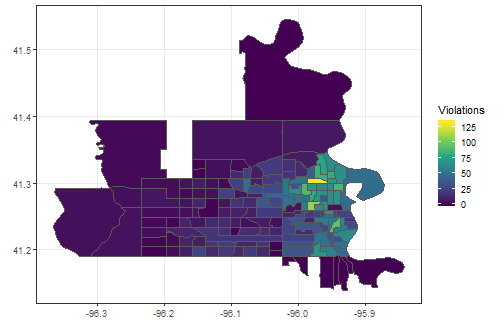
ggplot(tracts) + geom_sf(aes(fill = pred_nViol)) + labs(fill = 'Violations') + scale_fill_viridis_c() + theme_bw()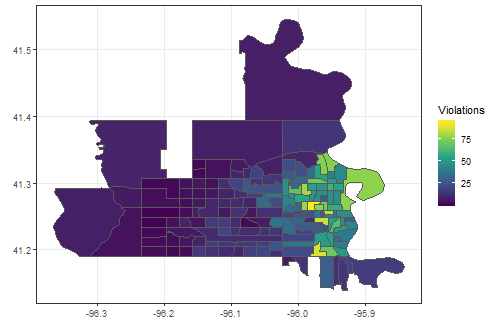
Spatial Error
ggplot(tracts) + geom_sf(aes(fill = pred_error)) + scale_fill_viridis_c(option = 'cividis') + theme_bw()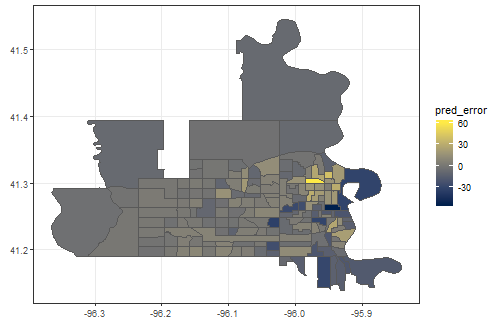
GIS Data Files (Rasters)
GIS Data Files (Rasters)
- Rasters graphics are a very generic object class
GIS Data Files (Rasters)
- Rasters graphics are a very generic object class
- For GIS analysis, a spatial raster is divided into equal units of the CRS
GIS Data Files (Rasters)
- Rasters graphics are a very generic object class
- For GIS analysis, a spatial raster is divided into equal units of the CRS
- A raster is an array with pixel location on an X-Y plane and has topological information contained at the each location
GIS Data Files (Rasters)
- Rasters graphics are a very generic object class
- For GIS analysis, a spatial raster is divided into equal units of the CRS
- A raster is an array with pixel location on an X-Y plane and has topological information contained at the each location
aNames <- c(lapply(c("X", "Y"), paste0, 1:2), list(c("R", "G", "B")))array(rnorm(10), dim = c(2,2,3), dimnames = aNames), , R Y1 Y2X1 -0.03789851 -0.9039875X2 -0.31576897 0.4371677, , G Y1 Y2X1 -0.3617482 1.200864X2 0.6089799 0.646111, , B Y1 Y2X1 -0.2890454 -0.03789851X2 1.5248314 -0.31576897Working with Rasters
Working with Rasters
sf does not have raster abilities yet
Works on large files because it can divide and conquer
Working with Rasters
sf does not have raster abilities yet
Works on large files because it can divide and conquer
RasterLayer, RasterStack, RasterBrick
Working with Rasters
sf does not have raster abilities yet
Works on large files because it can divide and conquer
RasterLayer, RasterStack, RasterBrick
Bounding Box for Omaha Area
library(raster)coords <- centroids[[1]]bb <- c(xmin = -96.268204, xmax = -95.742829, ymin = 41.109533, ymax = 41.393063)plot(extent(bb))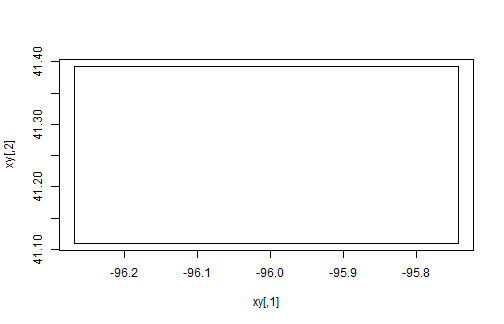
Shuttle Radar Topography Mission
srtm <- getData('SRTM', lat = coords[2], lon = coords[1], path = 'dataWS/altitude', download = TRUE)srtm <- crop(srtm, extent(bb), snap='out')plot(srtm)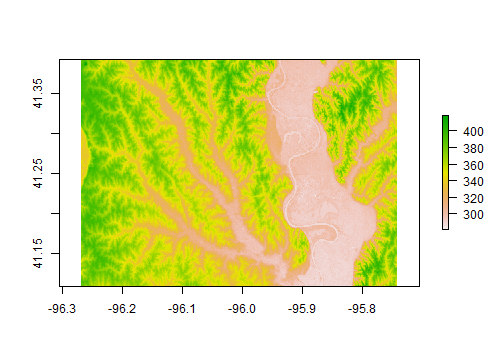
Slope
slope <- terrain(srtm, opt='slope')plot(slope)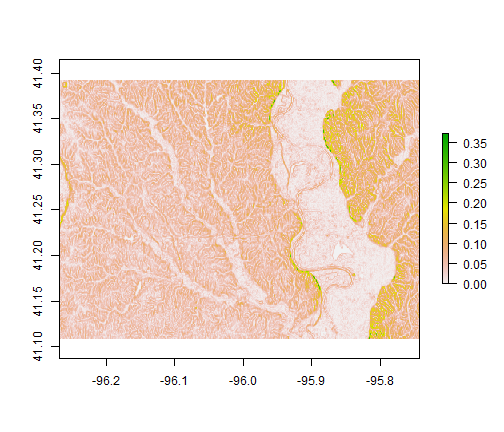
Aspect
aspect <- terrain(srtm, opt='aspect')plot(aspect)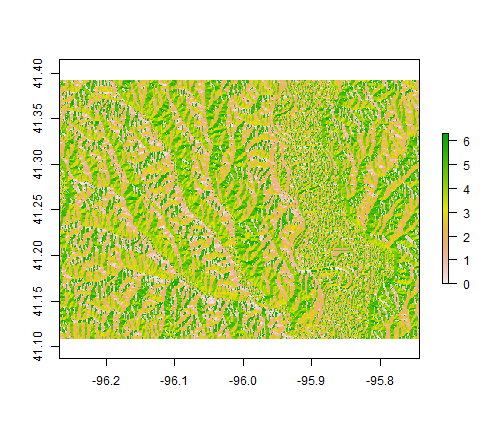
Hill Shade
hs <- hillShade(slope, aspect, 10, 217.92)plot(hs, col= heat.colors(25))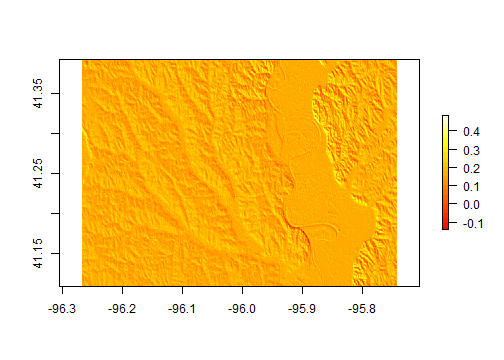
Hill Shade
hs <- hillShade(slope, aspect, 90, 217.92)plot(hs, col= heat.colors(25))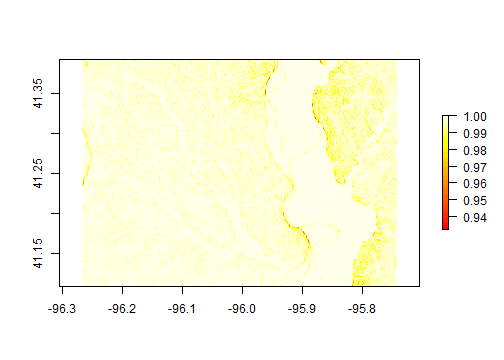
Contour Lines
hs <- hillShade(slope, aspect, 45, 217.92)plot(hs, col= heat.colors(25))omahaContour <- rasterToContour(srtm, maxpixels = 500)plot(omahaContour, add = TRUE)
Shiny Web Applications
Lightweight framework for web applications
Use R engine for analysis
R Interface to producing HTML, Javascript for User Interface
Customizable HTML, CSS, and Javascript
install.packages('shiny')install.packages('shinythemes')install.packages('osrm')Open Source Routing Machine
library(osrm)driveTime <- osrmIsochrone(loc = c(-95.9980, 41.2524))driveTimeclass : SpatialPolygonsDataFrame features : 6 extent : -96.92043, -95.16736, 40.522, 41.94424 (xmin, xmax, ymin, ymax)coord. ref. : +init=epsg:4326 +proj=longlat +datum=WGS84 +no_defs +ellps=WGS84 +towgs84=0,0,0 variables : 4names : id, min, max, center min values : 1, 0, 10, 5 max values : 6, 50, 60, 55Self Service Isochrone
User Input
- Coordinates
- Drive Times
- Background map
Output
- map of drive times
- ability to download shapefiles
Shiny Template
ui <- fluidPage()server <- function(input, output) {}shinyApp(ui, server)reactive programming environment
inputis provided by the end useroutputis processed by the server based oninputand rendered to the end usersingle file application